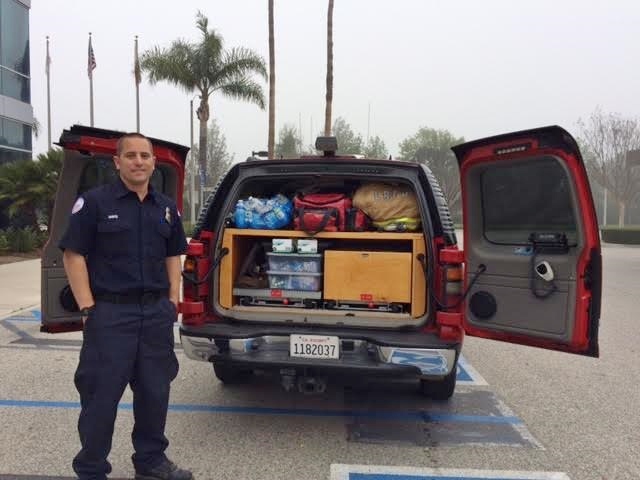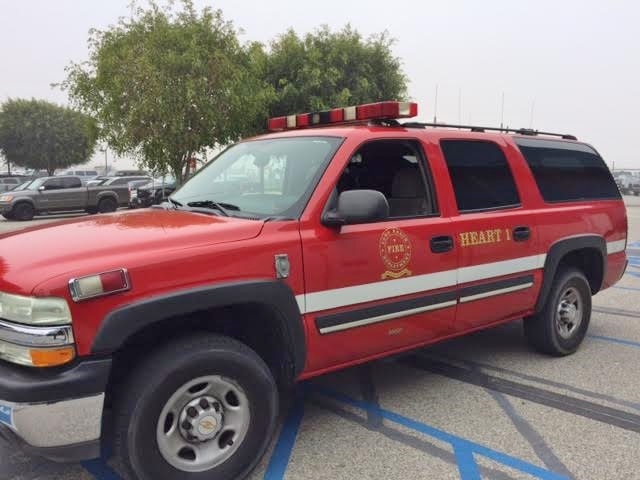Firefighter-paramedics Joel Davis and Justin Verga conduct homeless outreach in Long Beach. Photos by Michalea Kwoka-Coleman.
For Joel Davis and Justin Verga, being a part of the Long Beach community means making sure the basic needs of the most vulnerable citizens are met – that’s just what a community is supposed to do.
Together, the two firefighter-paramedics with the Long Beach Fire Department (LBFD) make up the Homeless Education And Response Team (HEART).
The idea for the program originated two years ago as a way for the fire department to increase its response to people experiencing homelessness, according to LBFD Deputy Chief of Operations James Rexwinkel.
{loadposition adfloat}
Davis said the program is “very new and very unique to Long Beach.”
With funding from Proposition H, which voters approved in May 2007, LBFD was allotted a one-time amount of $250,000 to form the team.
Davis and Verga spend their day driving around different areas of Long Beach, listening and waiting for a dispatch call that sounds like it could be about someone who is experiencing homelessness.
If they are near the call’s location, they respond.
“Somebody driving down the road calls 9-1-1 because they see somebody lying down on the corner of Lakewood and Spring… more than likely, that’s somebody experiencing homelessness,” Davis said.
By them responding to the call instead of a fire engine company, resources can be better distributed, which impacts the system in a positive manner, Davis added.

THE MOBILE OFFICE
As Davis and Verga spend their 10-hour work days driving around Long Beach, their SUV doubles as their office, which they say helps them better serve the homeless population.
 “Being the mobile unit, it knocks a good minute or two off the response time for the other units responding, just us being mobile in nature,” Verga said.
“Being the mobile unit, it knocks a good minute or two off the response time for the other units responding, just us being mobile in nature,” Verga said.
“It’s by design too,” Davis added. “If we’re sitting at an office, at headquarters for example or having to go to a fire station to do our reports and stuff like typical units, we’re not on the street, and if we’re not on the street then we’re not able to jump on some of those calls.”
Their ability to respond to calls involving people who may be experiencing homelessness helps free up resources for other medical emergencies.
Davis said this is one of the biggest successes of the program so far.
“It’s showing a very positive impact on reduction on the call volume for some of the resources in town, keeping them available for the structure fires, the heart attacks and things like that,” he said.
Verga added that not taking homeless people to the ER who don’t have medical emergencies is freeing up beds for those who actually need them.
“It has a lot of trickle down effect in the entire system that’s not exactly easy to quantify, but it’s definitely still there,” he said.

File photo by Asia Morris.
MULTI-SERVICE CENTER
When HEART does respond to a call, they assess the individual’s needs in order to take the right course of action. If the person doesn’t need to be taken to a hospital, the team will start providing outreach and offer a ride to the Multi-Service Center in West Long Beach.
“We’ll kind of assess what their needs are at that point,” Davis said. “Whether they’re looking for housing, if they have mental illness, basic hygiene needs, we try to identify some of the things they need help with and then connect them with the right resources.”
There, homeless people can meet with caseworkers, receive non-emergency medical treatment, shower and take a shuttle to the winter shelter in North Long Beach, which is open until April 1 but could possibly become a permanent shelter location.
“Whatever their case may be, there’s someone there who can help them,” Davis said. “If they’re a veteran, there’s somebody there who only deals with veterans; if they’re a family, there’s somebody there who only deals with families; if it’s a female, there’s somebody there who only deals with females. So there’s really a good network of services that they provide.”
PROACTIVE OUTREACH
While HEART is always on the lookout to respond to emergencies, they spend a majority of their time doing proactive outreach within the community.
“Basically, we’ll go out, we’ll start conversations with folks, trying to get to know them, to build trust with them,” Davis said. “We don’t wait for someone to call 9-1-1 for them.”
The two men drive up and down the bike path along the L.A. River at least once a day, conversing with the people they know and introducing themselves to the newcomers.
“When we see someone new we don’t recognize, we’ll just stop, start chatting them up a little bit, find out what their story is,” Verga said. “Just start making that contact, start building that relationship, just let them know there’s someone that’s willing to help them if they want it, and when they’re ready, and that’s what a lot of it comes down to, when they’re ready.”
Not every person they approach wants services, in fact most people refuse. Davis said that some people are content with the way they live. However, that doesn’t mean they’ll always be content.
For most homeless people, the team said they need to hit rock bottom before they’ll come and seek services.
“When you get a ‘yes’ you got to act on it right then and there, because the longer you wait, the more likelihood they’re gonna get cold feet and back out and fall back in the cracks,” Verga said.
The most important aspect of their outreach is to respect the reality of the person with whom they’re engaging.
For homeless people who might be suffering from a mental illness such as schizophrenia, it’s important to approach them with respect and to be mindful of your body language.
“The second you start tearing that down is the second you’ve lost any type of relationship with that person,” Verga said. “Especially when you’re dealing with someone who’s got some kind of mental illness, whatever it may be. You’ve got to learn how to talk to people.”
Both men believe it’s not just their duty as firefighters or as part of HEART to help the homeless population, but simply their duty as Long Beach residents.
“When it’s in your backyard, it’s your obligation to help the problem, to assist in making sure the entire community is taken care of, that’s what a community does,” Davis said. “What people have to understand is that from every man and woman on the streets to every man and woman who are living well, they’re all still [part of] the community.”

